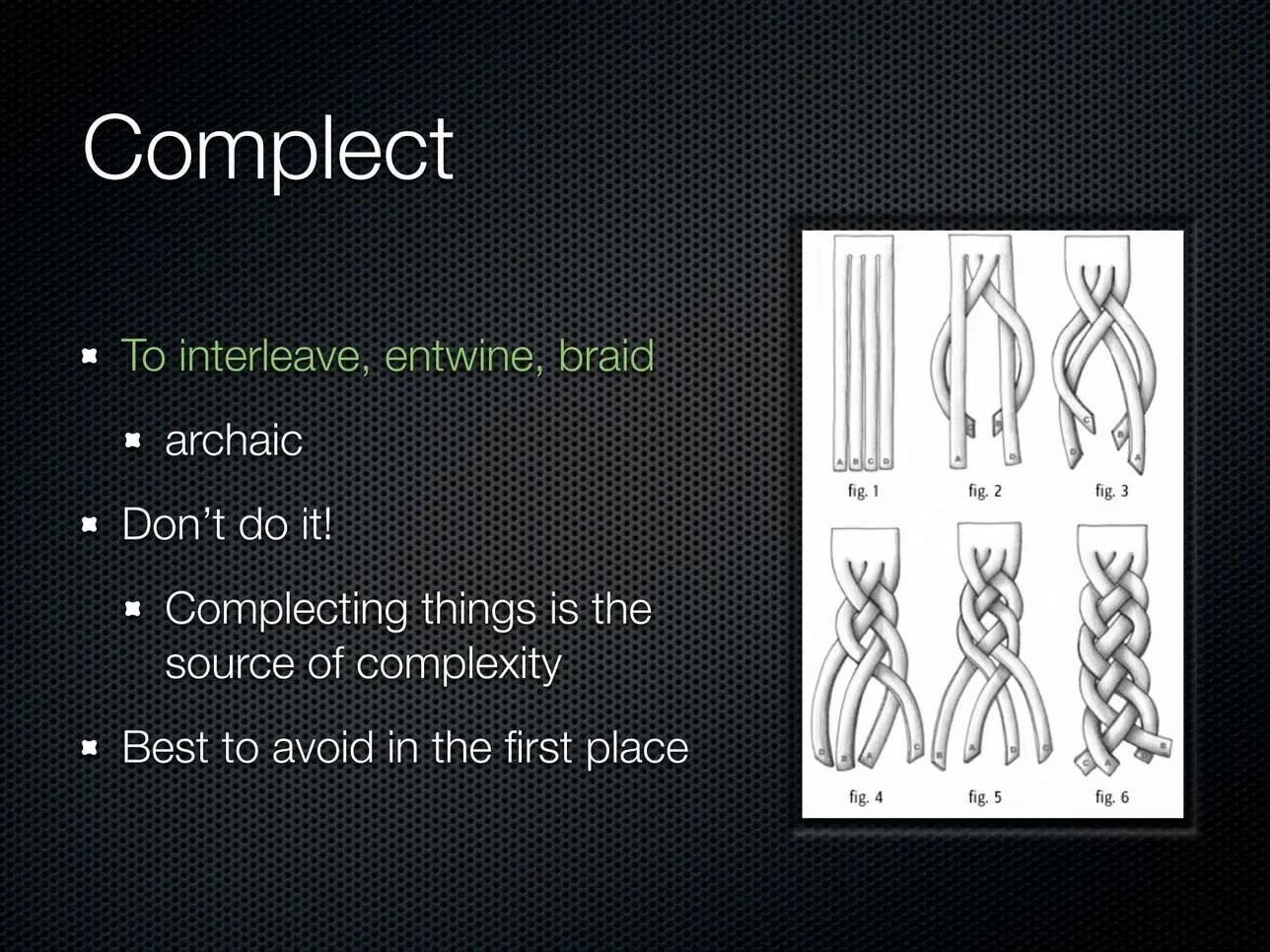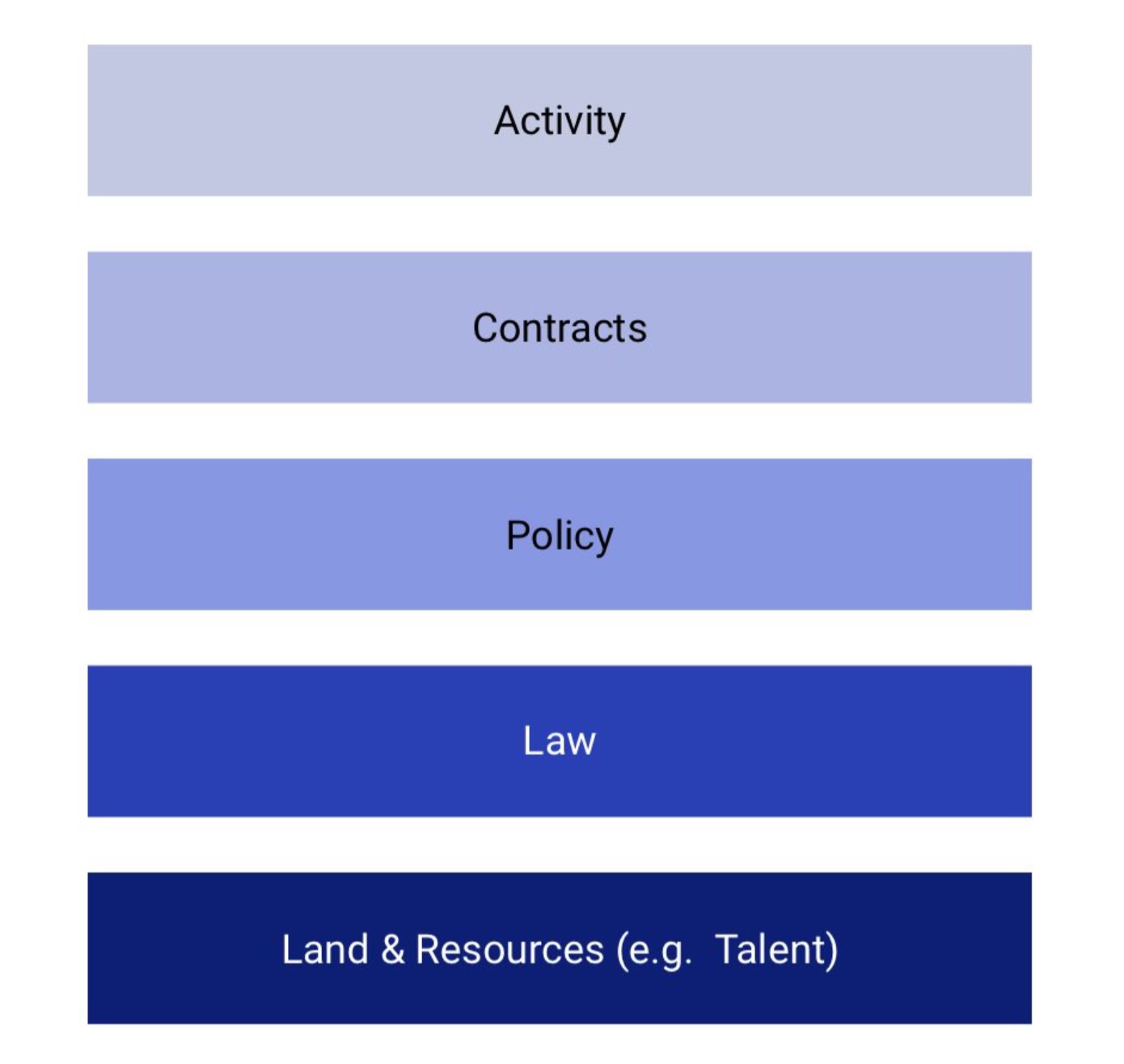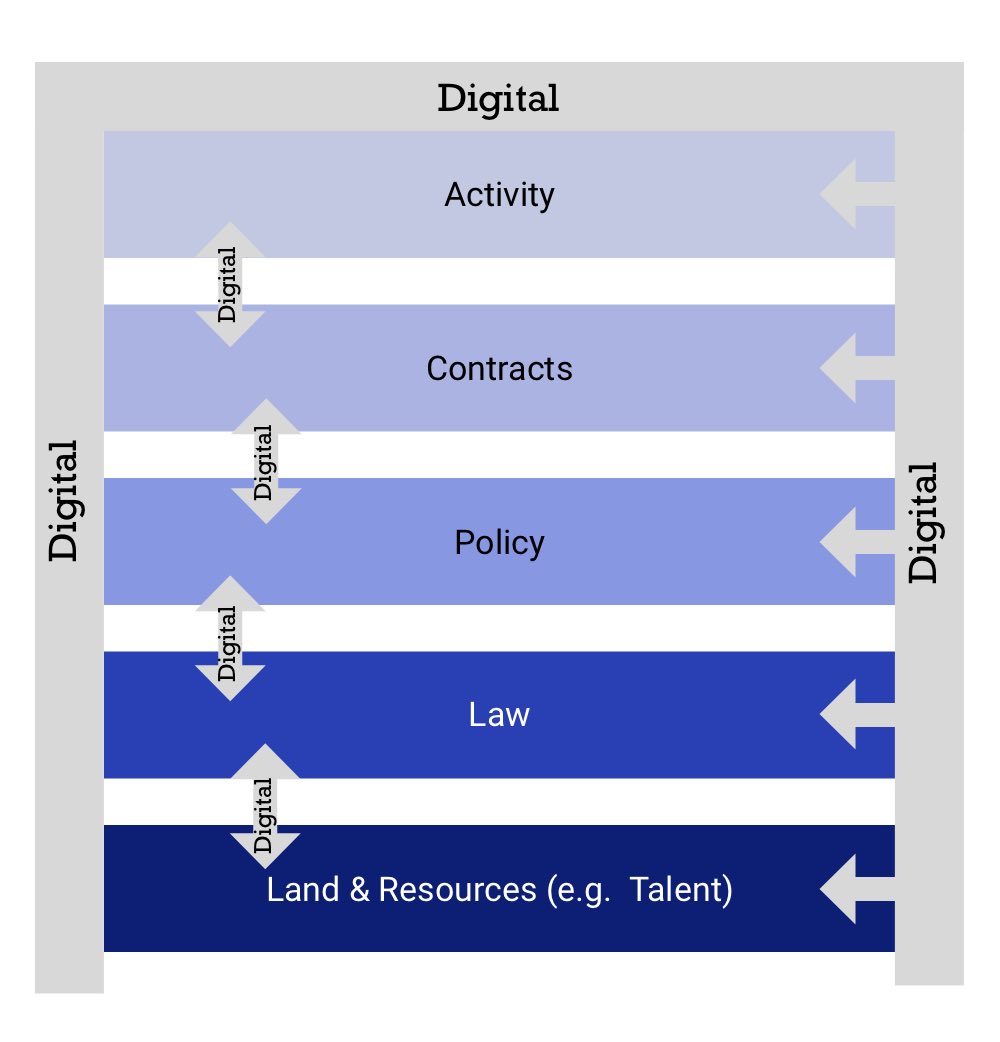Digitally Complementing and Complecting Singapore
(necessary caveat: this is entirely my own opinion, and doesn’t represent any official views of any Singapore government agency.)
complect, verb trans
- embrace
- Connect together; interweave.
complement, noun
- A thing which, when added, completes or makes up a whole.
- Shorter Oxford English Dictionary
In his seminal talk Simple Made Easy, Rich Hickey (creator of the Clojure language) revived the term complect, an archaic English word meaning to intertwine or to interweave.
 In the programming context, this is a bad thing: it is bad when things are intertwined, because the main job of programmers is to debug. How do you debug? By tracing back where the errors happened. And what happens when you try to trace things in intertwined threads? It’s a mess (which is why ‘spaghetti code’ is shorthand for messy badly written code). So complect is a shitstorm in code, hence you can see Rich’s advice: ‘best to avoid in the first place’.
In the programming context, this is a bad thing: it is bad when things are intertwined, because the main job of programmers is to debug. How do you debug? By tracing back where the errors happened. And what happens when you try to trace things in intertwined threads? It’s a mess (which is why ‘spaghetti code’ is shorthand for messy badly written code). So complect is a shitstorm in code, hence you can see Rich’s advice: ‘best to avoid in the first place’.
But I wonder if there is a time and place where complecting might actually make sense: after all, one needs to intertwine and braid in order to combine multiple smaller strands into a larger stronger rope, as shown in Rich’s slide diagram above. So there might be situations where it is advantageous to complect.
Digital: the great equalizer of space and time
Regardless of what is publicly said about Singapore’s digital focus, the reality is that there is an underlying tension between Singapore’s physicality vs. digital. Singapore as a nation and hub, is premised on the need to be physically present or near something, ideally many other locations. That is why we are a physical intermediary between East and West, an airhub, and a major transhipment port.
Digital completely disrupts Singapore’s physicality. To quote an ex-colleague, “digital is the great equalizer of space and time.” This sounds very abstract, so I’m going to use an example to illustrate what I mean: real estate vs. e-commerce.
It used to be that you needed to go to a shop to buy things. That requirement drove a certain economic logic: shops which were located near high footfall traffic areas tended to generate more revenue, as customers were much more likely to walk past, see the shop’s offerings and walk in to buy.
Then, in the last decade or so, something interesting happened: the rise of e-commerce, and the changing consumer patterns. Nowadays, people tend to go online to search for what they want, then buy. As a result, real estate footfall traffic for physical stores has dropped over the years (see here, for example), as physical stores compete against a different business model which has much lower costs (a web store is much cheaper and easier to maintain than a physical store). When you factor in other costs, like cheap shipping costs and lower labour costs in countries with more labour, not surprisingly digital e-commerce is undercutting a lot of the traditional retail stores globally.
Digital is disrupting the physical.
My guess is that something similar is happening to Singapore at the larger scale. Our physical advantages are being disrupted, much like a store which has high rent and used to have great foot fall is competing against digital stores which are search-engine-optimized, and have costs that are an order-of-magnitude lower.
Currently, from everything I have seen, our government is very focused on how can we use digital technologies to improve/automate/enhance our existing processes? Very seldom have I seen the thinking and investment into: how can we use digital technologies to enhance Singapore’s physical competitive advantages?
Digital Substitutes & Complements
If we factor in the microeconomic concept of substitutes and complements, maybe digital technologies can be divvied up into two:
- Messaging and video communication tools like Zoom & Whatsapp remove the need for physical space: they are direct substitutes for physical proximity.
- In contrast, Tinder, Google Maps, in-shop-online-ordering systems enhance operations in the real-world-space: they are digital complements to physical space.
Maybe, moving forward, it makes sense for Singapore to be clearer about what are Singapore’s digital complements, and to build and/or attract those.
Why? Because doing so will complect Singapore with the digital realm. The more we are able to intertwine ourselves with the digital realm, the less of a chance we have of being bypassed. We need to digitally complect Singapore with our complements, in order to reduce the digital substitution effect.
Some untested hypothetical examples to illustrate what I mean:
- a mobile app that allows businesses to find the most efficient routing for shipping in the region, through Singapore;
- a geo-fenced web app that is only open to Singapore-based individuals, which generates ASEAN and Asian business leads. This app directs users to the nearest possible regional business contacts present in Singapore;
- a web portal that draws on a combined database of all regional e-commerce platforms with a Singapore HQ (brokered by a Singapore govt agency between the competitors), which generates data-driven customer personas across the region (e.g. a Malaysian finance professional in his 30s living with a family of two; an Indonesian small-holder farmer with children working in Jakarta suburbs; a Vietnamese web developer working remotely for a tech startup; etc.) These data-backed personas are only available to Singapore-based companies with a RHQ, as well as Singaporean firms. Entrepreneurs and corporations based in Singapore can access these personas, and then hire Singapore-based design research agencies to fine-tune the reserach and create new offerings targeting these personas.
In each of these examples, being in Singapore is the ‘key’ which unlocks a set of digital benefits. I am sure more can be done, where digital complements reinforce Singapore’s existing physical advantages, but I can’t think of any at this point: your ideas and comments are most welcome!
A corollary of this: in the same way that Singapore has used land for economic purposes (and industrial land is largely administered through JTC), maybe we need a digital equivalent to JTC to help us develop digital economic tools which complement our physical advantages to help businesses. I’m not sure which agency is looking at this, right now.
Digital Cladding and Cake Icing
The other aspect of complecting Singapore with the digital realm has to do with connecting the different “Singapore stack” layers with each other. Using a tech stack analogy, we could think of Singapore as:

However, this is not an exact analogy. In, say, an internet network stack, the tech stack allows transactions of information to take place between the layers, which allows an overall transaction to take place.
In contrast, in the Singapore stack, there is a lack of clear protocols between the different layers, which are more like a haphazard kueh lapis (i.e. simply stacked on top of each other) than an internet packet. We leave it to market forces for these transactions to occur between the layers or within the layers, and there’s nobody optimizing for this in Singapore.
This is where digital as ‘the great equalizer of space and time’ comes in very handy. Because with the right protocols & tools, you can improve the interactions between layers at scale, even if there is no central architect. Digital is like a cladding, or cake-icing that goes over all the different layers. The Singapore stack then looks like this:

The term “protocol” is probably key here, because you need some standardization and way to allow different parties in different parts of the stack to be able to communicate, much like TCP/IP (both protocols!) has allowed a random server to serve your website to your phone, your laptop, and some random dude in India’s device.
Conclusion
This writeup has written about creating digital complements to complect Singapore with the digital realm. These are just some of my thoughts. Your feedback and comments are most welcome!